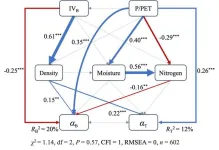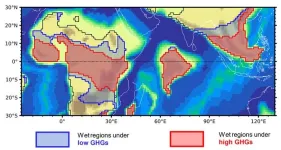(Press-News.org) When a forest is lost to development, some effects are obvious. Stumps and mud puddles across the landscape, a plowed field or houses a year after that. But deforestation isn’t just a loss of trees; it’s a loss of the countless benefits that forests provide—one of which is control of disease.
Now, a startling new global study shows that a widespread malaria-fighting strategy—bed nets—becomes less effective as deforestation rises. The research underscores how important a healthy environment can be for human health.
Insecticide-treated bed nets are one of the most common malaria prevention measures. They prevent malaria-transmitting mosquitos from biting residents as they sleep, and nonprofits distribute them widely, spending into the billions of dollars, said Gund Institute Director Taylor Ricketts.
The researchers found that bed-net use was associated with up to 32% lower malaria rates in children. However, bed-nets were only effective in areas where forests remained over 50% intact. The findings were published in People and Nature.
In other words, “bed-net use is effective in areas with lower deforestation rates, but when deforestation rate exceeds 50% over the 20-year period studied, bed-net use has no effect,” said lead author Tafesse Estifanos, a former postdoctoral scholar at UVM’s Gund Institute for Environment and still an affiliated scholar there.
“Tafesse’s research is a wake-up call for those working in public and planetary health. He has shown that the effectiveness of what we typically do to control malaria depends on the state of nature around the people we're trying to help,” Ricketts said. “I think in global public health, there is still a huge blind spot regarding the importance of nature.”
For the study, the researchers combined several types of information: demographic, health, and economic data about residents of the study area—combined with geographic and environmental data including deforestation, climate, and population density. They developed four categories of deforestation rate, ranging from nearly no forest loss to over 50% loss over the course of 20 years. The team also included data on bed-net use and malaria cases among children residing in the study areas.
Why does deforestation increase malaria risk? There are probably several interacting reasons, noted Ricketts, but one of them is that deforestation creates ideal habitat for malaria-carrying mosquitoes, leaving puddles of sun-warmed water in which the insects breed and thrive. The researchers next plan to look for the exact mechanism through which forest loss changes bed-net efficacy, Ricketts added.
This work builds from an earlier study, in which researchers showed that deforestation increases risk of malarial infection in children across six countries, especially for those in low-income communities.
“We have lots of case studies that look at the adoption and efficacy of malaria prevention, especially bed net access and use,” noted study coauthor and Rubenstein School of Environment professor Brendan Fisher. “What we were able to do here is get data on close to 20,000 children in six malaria-endemic countries to test, on a large scale, how natural and human mechanisms for malaria prevention interact."
The take-home message, said Estifanos and Ricketts, is that maintaining intact forests is not just a conservation goal—it’s a public health measure. “Especially in developing countries, where the resources are scarce and poverty is a significant factor, conservation of the environment has a dual purpose,” Estifanos said.
It also means that government and NGO efforts to improve public health—and the money spent on these efforts—can be wasted if deforestation overwhelms their effectiveness, Ricketts said. “If we don’t treat nature well, we could undermine the impressive gains we’ve made in public health.”
“By conserving the environment, we can help public health policy interventions,” Estifanos said. “Our project examines how poverty and environmental conservation interact in malaria transmission, and shows that environmental conservation has public health benefits.”
World Health Organization data reports over 600,000 deaths worldwide from malaria in 2022, nearly all of which occurred in Africa. Children are particularly vulnerable: over 75% of these malaria deaths were children.
Learn about UVM’s Planetary Health Initiative, which explores connections between nature and human health so that people and planet can thrive.
END
Deforestation reduces malaria bed nets’ effectiveness
Trees and disease: Public health measures to fight malaria—including insecticide-treated bed nets—lose effectiveness as deforestation rises
2024-12-05
ELSE PRESS RELEASES FROM THIS DATE:
Researchers develop polarization photodetector mimicking desert ant
2024-12-05
Polarization photodetectors (pol-PDs) have widespread applications in geological remote sensing, machine vision, and biological medicine. However, commercial pol-PDs usually require bulky and complicated optical components and are difficult to miniaturize and integrate.
Chinese researchers have recently made important progress in this area by developing an on-chip integrated polarization photodetector.
This study, published in Science Advances on Dec. 4, was conducted by Prof. Li Mingzhu’s group from the Technical ...
Superconducting qubit baths give clean simulation of quantum transport
2024-12-05
Researchers from Singapore and China have used a superconducting quantum processor to study the phenomenon of quantum transport in unprecedented detail.
A better understanding of quantum transport, which can refer to the flow of particles, magnetisation, energy or information through a quantum channel, could propel advances in technologies such as nanoelectronics and thermal management.
“We’re quite excited because this is, practically, a new paradigm of doing quantum transport experiments,” says Centre for Quantum Technologies (CQT) Fellow Dario Poletti, whose co-corresponding authors for the new work published in Nature ...
Astronomers witness the in situ spheroid formation in distant submillimetre-bright galaxies
2024-12-05
An international team of researchers including The University of Tokyo Kavli Institute for the Physics and Mathematics of the Universe (Kavli IPMU, WPI) has found evidence showing that old elliptical galaxies in the universe can form from intense star formation within early galaxy cores. This discovery will deepen our understanding of how galaxies evolved from the early Universe, reports a new study in Nature.
Galaxies in today’s Universe are diverse in morphologies and can be roughly divided into two categories: younger, disk-like spiral galaxies, ...
Effects of bamboo invasion on forest structures and diameter–height allometries
2024-12-05
Bamboo invasion has been widely observed across Asia (e.g., China, Japan, and India), North America, South America (e.g., Brazil and Peru) and Africa. Moso bamboo (Phyllostachys edulis), a large-running bamboo species native to subtropical China, is known for its invasive nature and ability to encroach upon adjacent communities, particularly derived forests. While some plot-based studies exist, our understanding of how forest structural dynamics and diameter–height allometric relationships respond to bamboo invasion has remained limited.
In a study published in the KeAi journal Forest Ecosystems, researchers from China ...
Ultrasonication as a tool for directing cell growth and orientation
2024-12-05
Developing reliable methods to replace dead or damaged tissue is one of the primary goals of regenerative medicine. With steady advances in tissue engineering and biomedicine, we are almost at a point where growing cell sheets in the lab and transplanting them onto damaged or diseased organs is becoming a reality rather than fiction. Notably, myoblast cell sheets have already been used to successfully treat severe heart failure, demonstrating the potential of this technology.
However, there are still a few unsolved challenges ...
Lessons from Earth's hottest epoch in the last 65 million years: How global warming could shrink the tropics' rain belt
2024-12-05
Earth's tropical rain belt, responsible for monsoons that sustain billions of people and vibrant ecosystems, has long been a reliable feature of the planet's climate. But new research reveals this vital system wasn't always so dependable. A study published in Geophysical Research Letters shows that during the early Eocene—the hottest period in the last 65 million years—the rain belt's seasonal shifts weakened dramatically. These ancient changes could offer critical warnings about the impact of modern global warming.
A Greenhouse Climate 50 Million Years ...
Independent rice paddy methane model validated for global applications: Study highlights emission mitigation potential
2024-12-05
Rice paddies, responsible for approximately 10% of global anthropogenic methane (CH₄) emissions, are increasingly recognized as a key contributor to global warming. Reducing emissions from rice cultivation is essential to achieving international climate goals, especially in light of commitments to carbon neutrality and peak emissions targets.
A team led by Prof. LI Tingting from the Institute of Atmospheric Physics at the Chinese Academy of Sciences has validated an independently developed methane emission model, CH4MOD, at the global scale. This research highlights the advantages of process-based models over the commonly ...
Infertility linked to onset of systemic autoimmune rheumatic disease after childbirth
2024-12-05
Women who experience infertility but do not use fertility treatments have a higher risk of developing a group of conditions called systemic autoimmune rheumatic diseases (SARD) in the nine years after a naturally conceived birth compared to women without fertility problems.
The new research, published today (Thursday) in Human Reproduction [1], one of the world’s leading reproductive medicine journals, found that this was true even after accounting for higher rates of pre-eclampsia (high blood pressure during pregnancy), preterm birth ...
Researchers use data from citizen scientists to uncover the mysteries of a blue low-latitude aurora
2024-12-05
Colorful auroras appeared around Japan's Honshu and Hokkaido islands on May 11, 2024, sparked by an intense magnetic storm. Usually, auroras observed at low latitudes appear red due to the emission of oxygen atoms. But on this day, a salmon pink aurora was observed throughout the night, while an unusually tall, blue-dominant aurora appeared shortly before midnight.
Smartphone videos and amateur photos captured the event, enabling scientists to combine public data with their own research and study the phenomenon.
In a ...
Possible colon cancer vaccine target uncovered in bacteria
2024-12-05
Higher rates of certain cancers in countries, such as the UK, may be linked to two particular strains of bacteria. Targeting these with treatments or vaccines could help reduce the risk of colorectal, bladder, and prostate cancers.
Researchers from the Wellcome Sanger Institute, the University of Helsinki, and collaborators investigated the differences in cancer incidence for colorectal, bladder and prostate cancers, and compared these to global data tracking Escherichia coli (E.coli) strains. Specifically, they looked at the dominant two E.coli strains that produce a substance that has been previously identified as a risk factor for colorectal cancer.
Their ...
LAST 30 PRESS RELEASES:
House sparrows in northern Norway can help us save other endangered animals
Crohn's & Colitis Foundation survey reveals more than 1/3 of young adults with IBD face step therapy insurance barriers
Tethered UAV autonomous knotting on environmental structures for transport
Decentralized social media platforms unlock authentic consumer feedback
American Pediatric Society announces Vanderbilt University School of Medicine as host institution for APS Howland Visiting Professor Program
Scientists discover first method to safely back up quantum information
A role for orange pigments in birds and human redheads
Pathways to net-zero greenhouse gas emissions for Southeast Asia
A JBNU–KIMS collaborative study on a cost-effective alloy matches superalloys for power plants and energy infrastructure
New study overturns long-held model of how plants coordinate immune responses.
New AI model predicts disease risk while you sleep
Scientists discover molecular ‘reshuffle’ and crack an 80-year-old conundrum
How stressors during pregnancy impact the developing fetal brain
Electrons lag behind the nucleus
From fungi to brain cells: one scientist's winding path reveals how epigenomics shapes neural destiny
Schizophrenia and osteoporosis share 195 genetic loci, highlighting unexpected biological bridges between brain and bone
Schizophrenia-linked genetic variant renders key brain receptor completely unresponsive to both natural and therapeutic compounds
Innovative review reveals overlooked complexity in cellular energy sensor's dual roles in Alzheimer's disease
Autism research reframed: Why heterogeneity is the data, not the noise
Brazil's genetic treasure trove: supercentenarians reveal secrets of extreme human longevity
The (metabolic) cost of life
CFRI special issue call for papers: New Frontiers in Sustainable Finance
HKU Engineering scholar demonstrates the smallest all-printed infrared photodetectors to date
Precision empowerment for brain "eavesdropping": CAS team develops triple-electrode integrated functional electrode for simultaneous monitoring of neural signals and chemical transmitters during sleep
Single-capillary endothelial dysfunction resolved by optoacoustic mesoscopy
HKU three research projects named among ‘Top 10 Innovation & Technology News in Hong Kong 2025’ showcasing excellence in research and technology transfer
NLRSeek: A reannotation-based pipeline for mining missing NLR genes in sequenced genomes
A strand and whole genome duplication–aware collinear gene identification tool
Light storage in light cages: A revolutionary approach to on-chip quantum memories
Point spread function decoupling in computational fluorescence microscopy
[Press-News.org] Deforestation reduces malaria bed nets’ effectivenessTrees and disease: Public health measures to fight malaria—including insecticide-treated bed nets—lose effectiveness as deforestation rises







